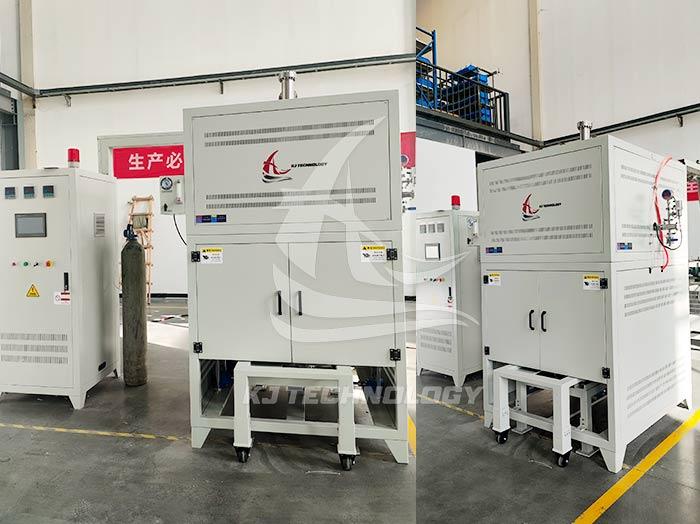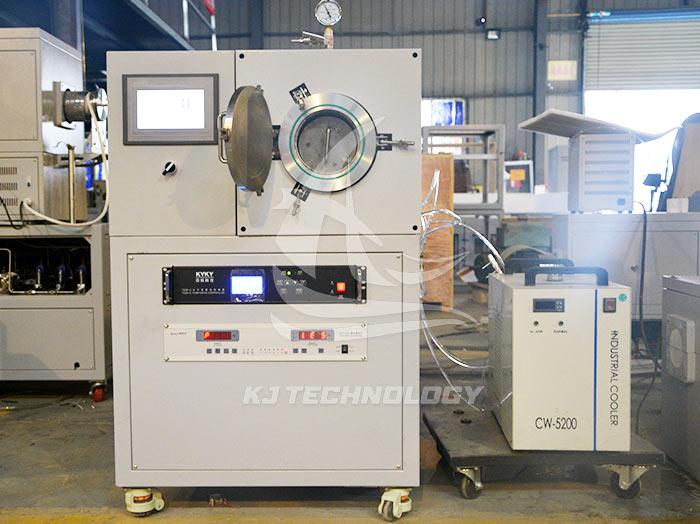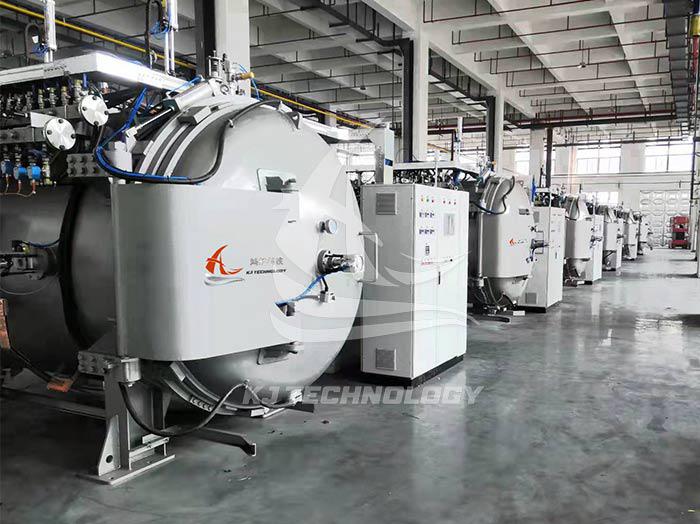What are the advantages of vacuum heat treatment atmosphere furnace compared to traditional atmosphere furnace?
 06-30-2025 Author: KJ technology
06-30-2025 Author: KJ technology
Compared with traditional atmosphere furnaces, vacuum heat treatment atmosphere electric furnaces have significant advantages in material processing quality, process control accuracy, environmental protection and energy saving, and application flexibility. The following is a specific comparative analysis:
1. Material processing quality: no oxidation and high purity cleanliness
Avoid oxidation and decarbonization
Advantages of vacuum furnace: In a vacuum environment (≤ 10 ⁻ ³ Pa), there is no oxygen contact on the material surface, completely eliminating the oxidation layer and decarburization phenomenon. For example, after vacuum quenching, the surface hardness uniformity of high-speed steel cutting tools increases by 20%, and there is no need for subsequent acid washing and rust removal, reducing material loss.
Traditional furnace limitations: Even with protective atmospheres such as nitrogen and methanol cracking gas, micro oxidation may still occur due to insufficient atmosphere purity or leakage, affecting material fatigue life (such as reducing gear contact fatigue strength by 15% -30%).
Reduce the risk of hydrogen embrittlement
Advantages of vacuum furnace: The vacuum environment can effectively remove hydrogen adsorbed in materials (such as reducing the hydrogen content in titanium alloys to below 0.001%), avoiding hydrogen induced delayed fracture. For example, after vacuum annealing, the hydrogen embrittlement sensitivity index (HSI) of aviation fasteners decreased from 0.8 to 0.2, significantly improving safety.
Limitations of traditional furnaces: Hydrogen atmosphere furnaces may experience hydrogen infiltration into the interior of materials due to improper control of hydrogen partial pressure, increasing the risk of brittle fracture.
inhibiting grain growth
Advantages of vacuum furnace: There is no oxide film obstruction on the surface of the material in a vacuum environment, and the resistance to grain boundary migration is reduced. However, abnormal grain growth can be suppressed through precise temperature control (such as ± 1 ℃). For example, after vacuum solution treatment, the grain size grade of nickel based high-temperature alloys remains stable at ASTM 5-7, while traditional furnace treatment is prone to mixed crystal phenomena.
2. Process control accuracy: multi parameter collaborative regulation
Accurate control of atmosphere composition
Advantages of vacuum furnace: It supports dynamic adjustment of single or mixed atmospheres such as hydrogen, nitrogen, argon, methane, etc. (proportion error ≤ 0.5%), achieving precise control of surface modification processes such as carburizing, nitriding, and carbonitriding. For example, the depth control accuracy of the carburizing layer on automotive gears can reach ± 0.05mm, while traditional furnaces may have a deviation of ± 0.15mm due to atmospheric fluctuations.
Traditional furnace limitations: The atmosphere flow control relies on a float flowmeter, which has low accuracy (± 5%) and poor gas mixing uniformity.
Uniformity of temperature field
Advantages of vacuum furnace: Adopting multi zone independent temperature control technology (such as 6-zone heating) and radiation screen design, the temperature field uniformity inside the furnace reaches ± 5 ℃, avoiding local overheating or underheating. For example, during the sintering of hard alloys, a vacuum furnace can ensure the uniformity of cobalt phase distribution (σ ≤ 5%), while traditional furnaces are prone to cobalt pool defects due to large temperature gradients.
Traditional furnace limitations: single zone heating or simple zone temperature control, temperature uniformity is only ± 15 ℃, which affects the consistency of material properties.
Collaborative control of pressure and vacuum degree
Advantages of vacuum furnace: It can combine low-pressure carburizing (pressure ≤ 10 hPa) and high-pressure gas quenching (pressure ≥ 5 bar) to achieve rapid cooling and carbon concentration gradient control. For example, after low-pressure carburizing, the surface carbon concentration of mold steel shows a gradient distribution (from 1.2% to 0.8%), and the wear resistance is improved by 50%.
The limitation of traditional furnaces is that they can only indirectly affect the reaction rate by adjusting the atmosphere flow rate, and cannot achieve coordinated control of pressure and atmosphere.
3. Environmental Protection and Energy Efficiency: Low Carbon Production
Energy consumption reduction
Advantages of vacuum furnace: The vacuum environment reduces heat convection losses, combined with efficient insulation layers (such as molybdenum foil+graphite felt), resulting in a 20% -40% reduction in comprehensive energy consumption compared to traditional furnaces. For example, when processing 1 ton of high-speed steel, the power consumption of a vacuum furnace is about 1200 kWh, while a traditional furnace requires 1800 kWh.
Traditional furnace limitations: strong atmosphere convection at high temperatures, large heat loss, and the need for continuous introduction of protective gas, which increases energy consumption.
Reduction of exhaust emissions
Advantages of vacuum furnace: The enclosed vacuum system avoids harmful gas leakage and does not require the use of toxic quenching oil (such as rapid bright quenching oil), reducing VOCs emissions. For example, the VOCs emissions from vacuum oil quenching process are reduced by 90% compared to traditional oil quenching.
Traditional furnace limitations: Atmosphere furnaces may produce pollutants such as CO and NOx due to gas leaks or quenching oil volatilization, requiring expensive exhaust gas treatment equipment.
Improvement of material utilization rate
Advantages of vacuum furnace: Non oxidation treatment reduces machining allowance (such as reducing the allowance of blade parts from 0.5mm to 0.2mm), and increases material utilization by 15% -25%.
Traditional furnace limitations: The oxide layer needs to be removed by acid washing or sandblasting, resulting in material loss and surface damage.
4. Application flexibility: Multi scenario adaptation capability
Compatibility with complex processes
Advantages of vacuum furnace: It can integrate multiple processes such as vacuum brazing, vacuum annealing, vacuum sintering, and low-pressure carburizing, and replace multiple traditional furnaces with one device. For example, the production of aircraft engine turbine discs can be completed through a single vacuum furnace for solid solution, aging, and brazing processes, reducing the cycle by 40%.
Traditional furnaces have limitations: they have a single function and require multiple devices to be connected in series for production, which increases logistics costs and process risks.
Small batch and customized production
Advantages of vacuum furnace: flexible furnace chamber volume (1L-100L), supports rapid material exchange of samples ranging from gram to kilogram, suitable for laboratory research and development and small-scale trial production. For example, in the development of new materials, vacuum furnaces can achieve process validation of more than 10 batches per day, while traditional furnaces have low efficiency due to long material replacement time (≥ 2 hours/batch).
Limitations of traditional furnaces: Large capacity furnaces (≥ 500L) are suitable for large-scale production, but high energy and atmosphere consumption costs are incurred in small-scale production.
High end material processing capability
Advantages of vacuum furnace: It can process high-end materials sensitive to oxidation such as titanium alloy, cobalt chromium alloy, amorphous alloy, etc., meeting the strict requirements of industries such as aerospace and medical equipment. For example, after vacuum heat treatment, the biocompatibility qualification rate of cobalt chromium alloy used in artificial joints increased from 85% to 99%.
Traditional furnaces have limitations: they can only handle materials that are insensitive to oxidation, such as ordinary carbon steel and alloy steel.








